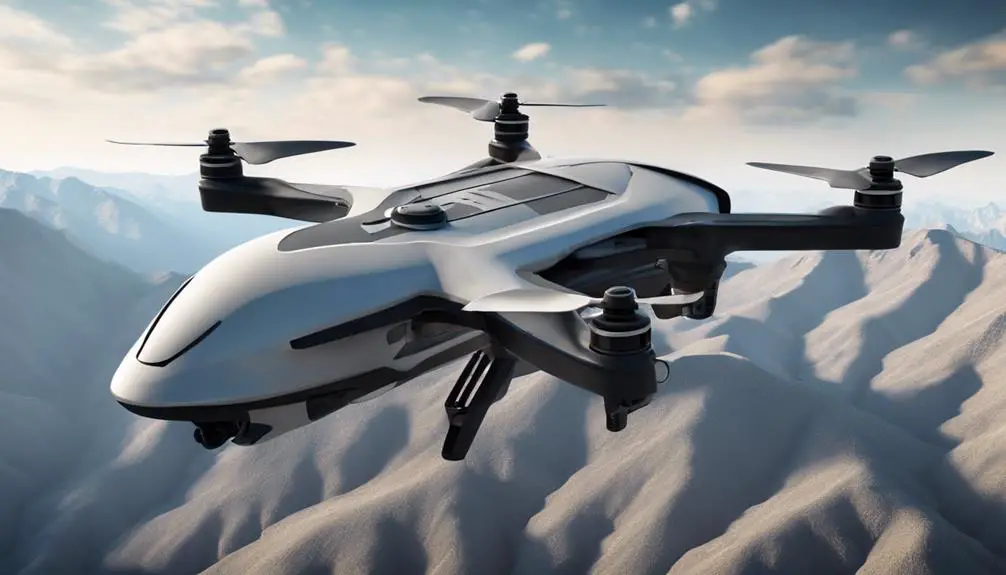Military drones can fly impressive distances, depending on their design and mission profile. Drones like the MQ-9 Reaper boast over 27 hours of flight endurance, while the RQ-4 Global Hawk can operate at altitudes of 60,000 feet, considerably extending its range. Factors like fuel capacity, payload weight, and environmental conditions can affect how far they can go. So, whether it's for surveillance or combat, drones are built for efficiency and endurance. If you're curious about the various types and their specific capabilities, there's plenty more to discover about military drones and their evolution.
Evolution of Military Drones
The evolution of military drones has transformed modern warfare, enabling you to conduct surveillance and strike missions with unprecedented precision and reach. These unmanned aerial vehicles (UAVs) started as simple reconnaissance tools, but advancements in technology have turned them into powerful assets. You can now gather real-time intelligence, assess battlefields, and strike targets while minimizing risk to human life. This shift empowers you to protect freedoms and respond swiftly to threats, enhancing your strategic capabilities. With drones, you're no longer tied to traditional methods of warfare; instead, you can operate from a distance, preserving lives while ensuring your nation's security. As military drones continue to evolve, they redefine your approach to conflict, providing a pathway toward greater autonomy and effective defense.
Factors Influencing Flight Range
Several key factors determine how far a military drone can fly, including fuel capacity, payload weight, and environmental conditions. If a drone has a larger fuel tank, it can cover more distance before needing to refuel. However, adding weight through equipment or weapons can reduce that range considerably, as the drone has to work harder to stay airborne. In addition, environmental factors like wind speed and altitude play an essential role. Strong winds can hinder a drone's ability to fly far, while high altitudes may require more energy to maintain stability. Understanding these elements is vital for maximizing a drone's operational range, ensuring it reaches its destination effectively and efficiently. Freedom in the skies depends on mastering these factors.
Types of Military Drones
Understanding the factors that influence flight range helps in appreciating the various types of military drones available today. You'll find several categories tailored to different missions and needs. For instance, there are surveillance drones designed for reconnaissance, providing real-time intelligence without putting personnel at risk. Then, you have combat drones, equipped with weapons to engage in direct conflict. Transport drones are another type, capable of delivering supplies to remote locations, enhancing logistical support. Additionally, there are research drones used for testing new technologies or gathering data in challenging environments. Each type serves a purpose, and their designs reflect the need for efficiency, safety, and effectiveness in military operations, allowing you to understand their essential roles in modern warfare.
Notable Military Drone Examples
Among the most notable military drones are the MQ-9 Reaper and the RQ-4 Global Hawk, each showcasing advanced capabilities tailored for specific operational needs. These drones symbolize a shift in modern warfare, emphasizing precision and surveillance without risking human lives. Here are three key features that highlight their significance:
- Endurance: The MQ-9 Reaper can fly for over 27 hours, enabling long-term missions.
- Altitude: The RQ-4 Global Hawk operates at 60,000 feet, providing a broad surveillance range.
- Payload Capacity: The Reaper can carry up to 3,750 pounds of weapons or surveillance equipment.
These capabilities not only enhance military effectiveness but also reflect a commitment to minimizing collateral damage, allowing for more responsible engagement in conflicts.
Future of Drone Capabilities
The future of drone capabilities promises to revolutionize military operations with advancements in AI, automation, and extended range, enabling unprecedented levels of efficiency and effectiveness in the field. Imagine drones that can autonomously gather intelligence, conduct surveillance, and even engage targets with minimal human intervention. These advanced systems will increase operational freedom, allowing you to respond swiftly to threats without risking lives. Additionally, enhanced battery technology and solar power integration could drastically extend flight times, making long-range missions feasible. As these innovations unfold, military drones could transform the way you perceive warfare, prioritizing precision and safety. Ultimately, the evolution of drone capabilities could empower your forces while minimizing collateral damage, aligning with the pursuit of freedom and ethical engagement in conflict.

